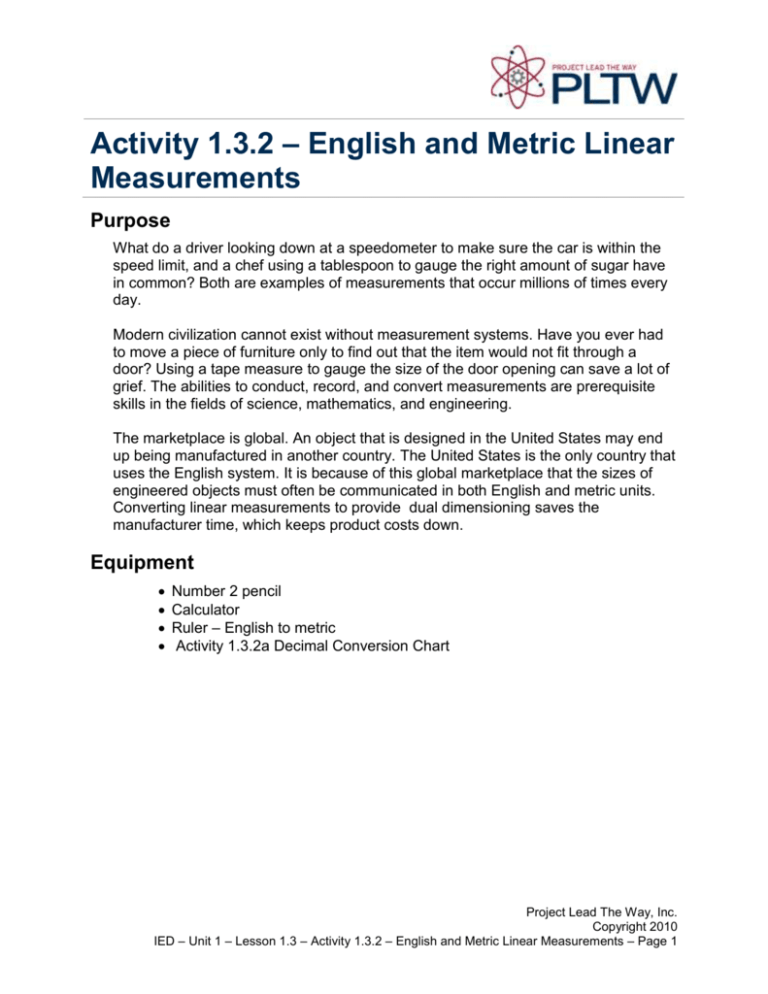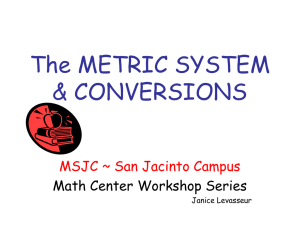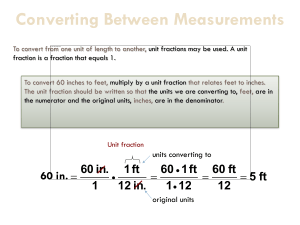English & Metric Linear Measurements Activity
advertisement

Activity 1.3.2 – English and Metric Linear Measurements Purpose What do a driver looking down at a speedometer to make sure the car is within the speed limit, and a chef using a tablespoon to gauge the right amount of sugar have in common? Both are examples of measurements that occur millions of times every day. Modern civilization cannot exist without measurement systems. Have you ever had to move a piece of furniture only to find out that the item would not fit through a door? Using a tape measure to gauge the size of the door opening can save a lot of grief. The abilities to conduct, record, and convert measurements are prerequisite skills in the fields of science, mathematics, and engineering. The marketplace is global. An object that is designed in the United States may end up being manufactured in another country. The United States is the only country that uses the English system. It is because of this global marketplace that the sizes of engineered objects must often be communicated in both English and metric units. Converting linear measurements to provide dual dimensioning saves the manufacturer time, which keeps product costs down. Equipment Number 2 pencil Calculator Ruler – English to metric Activity 1.3.2a Decimal Conversion Chart Project Lead The Way, Inc. Copyright 2010 IED – Unit 1 – Lesson 1.3 – Activity 1.3.2 – English and Metric Linear Measurements – Page 1 Procedure This activity will provide you with a foundation of basic measuring skills and simple mathematical calculations. Complete the following questions by placing your answers in the spaces provided. All inch measurements dealing with fractions must be answered in their lowest terms (i.e., 4/16 in = ¼ in). For example, if you solve a mathematical equation and the result is 4/16 in., your answer is not in lowest terms. The lowest term answer is ¼ in. If you are unsure why, you need to ask your teacher to explain. Your measurement accuracy on all measurements will be to the nearest 1/16 in. You will need to take your fractional answer and convert to decimal. All metric measurements must be answered to the nearest millimeter. To convert decimal inches to millimeters, multiply by 25.4. 2 in x 25.4 = 51 mm .75 in x 25.4 = 19 mm To convert millimeters to decimal inches, divide by 25.4 75 mm 25.4 = 2.95 in 10 mm 25.4 = .39 in Project Lead The Way, Inc. Copyright 2010 IED – Unit 1 – Lesson 1.3 – Activity 1.3.2 – English and Metric Linear Measurements – Page 2 Figure 1 Study Figure 1, and answer questions 1 through 8. Show all math work. 1. Is this an English or metric scale? 2. Distance A Fraction: Decimal: Metric: 3. Distance B Fraction: Decimal: Metric: 4. Distance C Fraction: Decimal: Metric: 5. Distance D Fraction: Decimal: Metric: 6. Distance E Fraction: Decimal: Metric: 7. What is the difference between distances A and C? Fraction: 8. Decimal: Metric: What is the difference between distances B and E? Fraction: Decimal: Metric: Project Lead The Way, Inc. Copyright 2010 IED – Unit 1 – Lesson 1.3 – Activity 1.3.2 – English and Metric Linear Measurements – Page 3 Figure 2 Study Figure 2, and answer questions 9 through 16. Show all math work. 9. Is this an English or metric scale? 10. Distance A Metric: Decimal: Fraction: 11. Distance B Metric: Decimal: Fraction: 12. Distance C Metric: Decimal: Fraction: 13. Distance D Metric: Decimal: Fraction: 14. Distance E Metric: Decimal: Fraction: 15. What is the difference between distances A and C? Metric: 16. Decimal: Fraction: What is the difference between distances B and E? Metric: Decimal: Fraction: Project Lead The Way, Inc. Copyright 2010 IED – Unit 1 – Lesson 1.3 – Activity 1.3.2 - English and Metric Linear Measurements – Page 4 17. Figure 3 shows a design of a mounting bracket for a dishwasher valve. This mechanical part, which was designed in the United States, is being out-sourced to a country using the metric system for manufacturing. Convert the inch dimensions to millimeters, and write your answer within the brackets. Figure 3 18. Optional: Figure 4 is a gasket for a go-cart engine. The drawing was created in a country using the metric system for manufacturing. The part is being mass produced in the United States. Convert the millimeter dimensions to inches so the part can be created. Write your answers in the brackets provided. Project Lead The Way, Inc. Copyright 2010 IED – Unit 1 – Lesson 1.3 – Activity 1.3.2 - English and Metric Linear Measurements – Page 5 Figure 4 Conclusion 1. Why is the metric system used instead of the English system, and vice versa, in various parts of the world? 2. When you look at a drawing, how do you know if you are looking at inch or millimeter values? Why is it important for an engineer to know this piece of information? 3. Why would you have to know how to convert measurements when looking at working drawing? Project Lead The Way, Inc. Copyright 2010 IED – Unit 1 – Lesson 1.3 – Activity 1.3.2 - English and Metric Linear Measurements – Page 6








